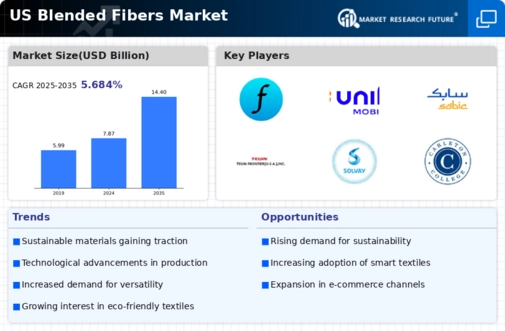US Blended Fibers Market Summary
The US Blended Fibers market is projected to grow significantly from 7.87 USD Billion in 2024 to 14.4 USD Billion by 2035.
Key Market Trends & Highlights
US Blended Fibers Key Trends and Highlights
- The market is expected to experience a compound annual growth rate (CAGR) of 5.68 percent from 2025 to 2035.
- By 2035, the market valuation is anticipated to reach 14.4 USD Billion, indicating robust growth potential.
- In 2024, the market is valued at 7.87 USD Billion, reflecting a strong foundation for future expansion.
- Growing adoption of blended fibers due to increasing demand for sustainable textiles is a major market driver.
Market Size & Forecast
| 2024 Market Size | 7.87 (USD Billion) |
| 2035 Market Size | 14.4 (USD Billion) |
| CAGR (2025-2035) | 5.68% |
Major Players
Lenzing AG, Mitsubishi Chemical Corporation, Invista, BASF SE, Unifi, Inc., SABIC, DuPont, Teijin Limited, Solvay, Eastman Chemical Company, W. L. Gore and Associates, Carleton College, Covestro AG, Huntsman Corporation

















Leave a Comment